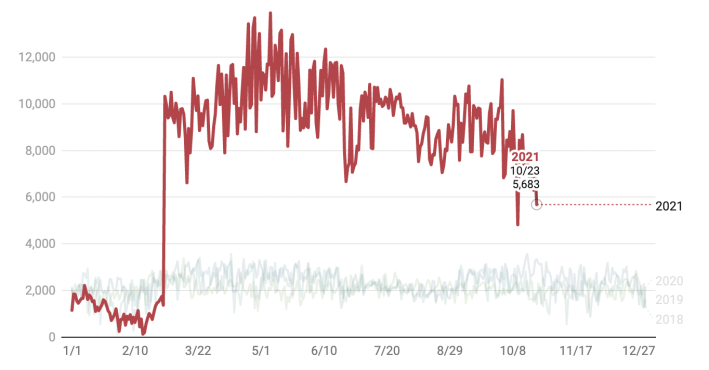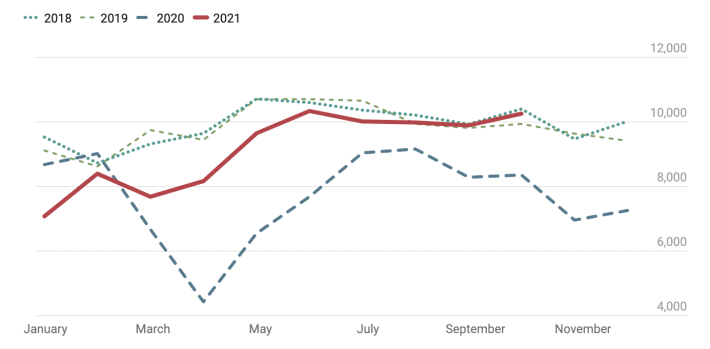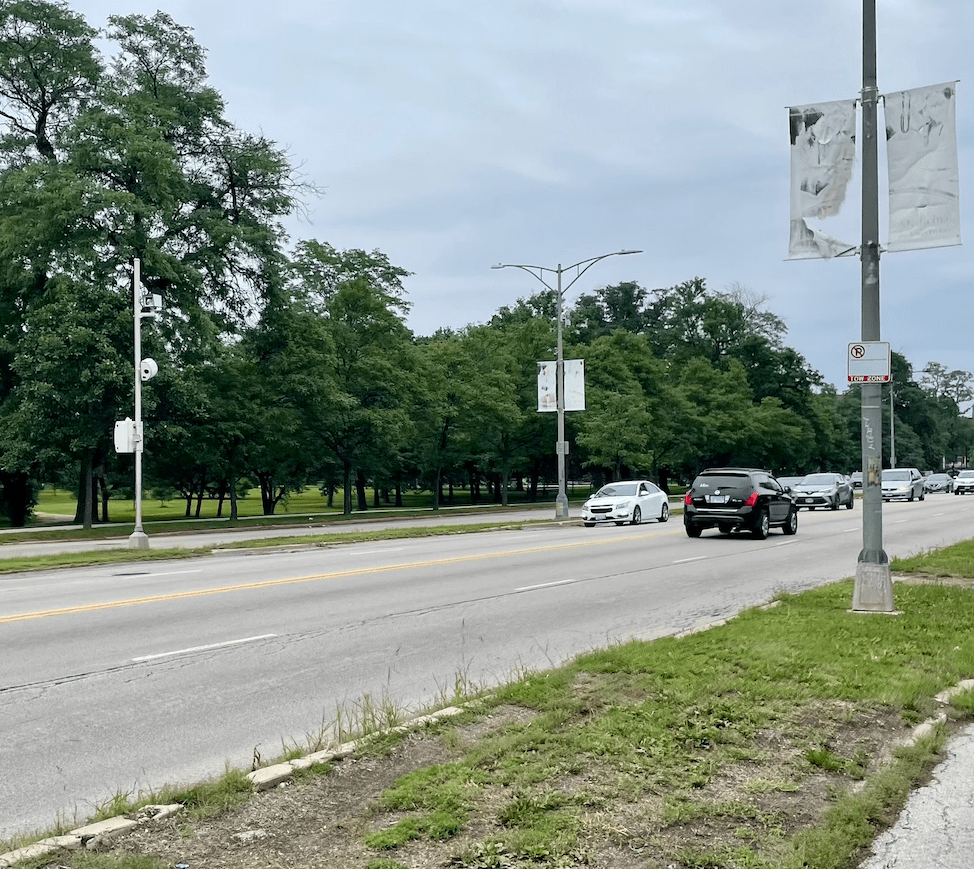Predictably, a new article on recent Chicago speed camera ticketing data from the the right-wing Illinois Policy Institute plays up the program's revenue generation, downplays its safety benefits, and contains plenty of misleading statements and outright misinformation. Let's get to work deconstructing it.
The IPI piece focuses on the increase in the number of citations issued since Mayor Lori Lightfoot's administration lowered the speed camera ticketing threshold from 10 mph over the speed limit to 6 mph on March 1 of last year. The article states that in the first ten months of 2021, the cams issued almost as many tickets as the previous three years combined, representing an eightfold increase in the rate of ticketing.
However, that doesn't mean that, under the new rule, the city is currently taking in anywhere near eight times as much ticket revenue per day compared to previous years. While the vast majority of the citations issued under the old threshold were $100 fines, tickets for speeding by 6-10 mph, which appear to account for most of last year's spike, are only $35. In many cases, the actual fee a driver is required to pay is even lower – more on that in a bit.
According to the IPI piece, from January to October 23 of 2021 the cameras issued $73.8 million in fines, roughly $30 million more than in each of the previous years. So the amount of revenue generated in 2021 was only about twice that generated each year in 2018, 2019, and 2020.
More importantly, the number of tickets issued in 2021 hit a peak of 13,889 citations on May 7, but then steadily dropped after that to only 5,683 tickets on October 23. Since far fewer motorists drove 6 mph or more over the limit in camera zones later in the year, that may indicate that the new threshold had the intended effect of encouraging safer speeds.

Just like a Chicago Tribune editorial published last August complaining about the new threshold, the implication of the IPI article is that if lots more people are being ticketed under the 6 mph rule, that means the policy is unfair. In reality, discouraging drivers from speeding by more than a few miles over the limit will save lives.
Studies show that while pedestrians struck at 20 mph almost always survive, and those struck at 30 mph have about a 60 percent chance of survival, those struck at 40 mph almost always die. So the difference between obeying Chicago’s default speed limit of 30 mph and ignoring it at 36-39 mph could easily be a matter of life or death.

For some reason, the IPI piece gives a fair amount of airtime to an editor named Vanessa Ortiz, who complained that she was recently ticketed by cameras in both directions while going on a coffee run. "It was a $70 cup," she said. "And of course, I didn’t know that until afterward when I got the notice for the two, I already received nine speeding tickets from the city.”
If Ortiz was unaware that she'd previously racked up multiple tickets, that's probably not the city of Chicago's fault. The city mails a warning to the address associated with each registered license plate the first time a driver of that vehicle violates the speed limit in a camera zone under the new 6 mph threshold. Only after that are fines issued for subsequent offenses.
Ortiz adds that the maximum speed she was ticketed at was 38. But, again, unlike the default 30 mph limit, that's a speed at which a struck pedestrian would probably die.
IPI argues that the Lightfoot's new ticketing rule "appears to renege on her promise to reform the city’s fines and fees program so they do not fall so heavily on needy residents." Actually, the administration has made a number of changes to the city's system of penalties for drivers to make it less regressive, such as a city sticker amnesty program, and an ordinance that ended impoundment for non-moving violations and made the impoundment fee structure more equitable.
Notably, Lightfoot's 2022 budget halved traffic fees for residents making less than $38,640 a year, which means many Chicagoans cited for driving 6-10 mph over the speed limit will only need to pay $17.50, which helps address concerns that automated enforcement disproportionately impacts low-income people.
The IPI piece amplifies false statements by 9th Ward alderman Anthony Beale, who unsuccessfully tried to raise the ticketing threshold back to 10 mph last March. “Frankly, we don’t even know for certain whether the cameras reduce crashes and fatalities," Beale said in a statement to IPI.
No, the safety benefits of Chicago's speed camera program are well-documented. According to a Chicago Department of Transportation analysis, speeding violations have dropped by an average of 53 percent near speed cameras within three months of the cams being activated.
While serious or fatal injury crashes spiked by 19 percent increase citywide between 2012-13 and 2017-18, likely because of more driving due to the rise of ride-hail use, that increase was only 1 percent near speed cameras. And while speed-related crashes went up by 75 percent across the city during that time period, the increase at camera locations was only 25 percent.

“Operating only in neighborhoods, the system is generating one ticket every [11] seconds and hundreds of thousands of dollars in revenues, extracting the most dollars from those who can least afford it," Beale told IPI.
Assuming Beale defines "neighborhoods" as areas outside the Central Business District, that's also inaccurate. There are three different speed camera zones within the CBD. And "those who can least afford it" will only have to pay half the usual $35 fine.
Buried near the end of the IPI article is a grudging acknowledgement that speed cameras aren't just an alleged money grab, but have significant safety benefits. "Speed cameras have been proven to reduce vehicle collisions and resulting injuries by as much as a 25 percent at conspicuous camera sites, according to studies. One study found the reduction in speeding rates spills over to neighboring unmonitored streets, leading to a decrease in virtually all types of collisions near cameras."
But IPI is quick to undermine that admission by implying that the 6 mph rule doesn't seem to preventing crashes because, while Chicago collisions decreased during the early days of the COVID-19 crisis, when there was less driving due to the stay-at-home order, by October of 2021 the collision rate was back to pre-pandemic levels.

However, it's not surprising that crashes returned to pre-COVID levels in 2021, because there was a major increase in driving after the vaccine was rolled out and workplaces and entertainment venues reopened. As such, the above graph doesn't really tell us anything about whether crashes have decreased at the speed camera locations since the 6 mph rule was introduced. I've asked CDOT for data on that, and will provide an update if the department provides it.
Vanessa Ortiz, the editor who racked up 11 speeding tickets, told IPI the 6 mph threshold is unfair to "safe drivers" like herself. “It changed the way I think about driving," she said. "I found I was worrying about the speed I was going."
Well, yes, that's the point.





